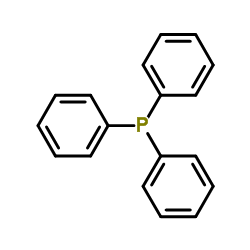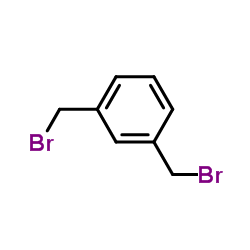p-xylylenebis(triphenylphosphonium bromide)
Modify Date: 2025-08-25 10:18:45

p-xylylenebis(triphenylphosphonium bromide) structure
|
Common Name | p-xylylenebis(triphenylphosphonium bromide) | ||
|---|---|---|---|---|
| CAS Number | 10273-74-2 | Molecular Weight | 788.52800 | |
| Density | N/A | Boiling Point | N/A | |
| Molecular Formula | C44H38Br2P2 | Melting Point | >300ºC(lit.) | |
| MSDS | N/A | Flash Point | N/A | |
| Name | triphenyl-[[3-(triphenylphosphaniumylmethyl)phenyl]methyl]phosphanium |
|---|
| Melting Point | >300ºC(lit.) |
|---|---|
| Molecular Formula | C44H38Br2P2 |
| Molecular Weight | 788.52800 |
| Exact Mass | 786.08200 |
| PSA | 27.18000 |
| LogP | 2.68280 |
| Appearance of Characters | liquid |
Synonym:None listed Section 2 - COMPOSITION, INFORMATION ON INGREDIENTS
Risk Phrases: 36/37/38 Section 3 - HAZARDS IDENTIFICATION EMERGENCY OVERVIEW
Irritating to eyes, respiratory system and skin.Hygroscopic (absorbs moisture from the air). Potential Health Effects Eye: Causes eye irritation. May cause chemical conjunctivitis. Skin: Causes skin irritation. May be harmful if absorbed through the skin. Ingestion: May be harmful if swallowed. Causes gastrointestinal tract irritation. Causes digestive tract irritation. Inhalation: Causes respiratory tract irritation. May be harmful if inhaled. Chronic: No information found. Section 4 - FIRST AID MEASURES Eyes: Immediately flush eyes with plenty of water for at least 15 minutes, occasionally lifting the upper and lower eyelids. Get medical aid immediately. Skin: Get medical aid immediately. Immediately flush skin with plenty of water for at least 15 minutes while removing contaminated clothing and shoes. Wash clothing before reuse. Ingestion: Never give anything by mouth to an unconscious person. Get medical aid immediately. Do NOT induce vomiting. If conscious and alert, rinse mouth and drink 2-4 cupfuls of milk or water. Inhalation: Get medical aid immediately. Remove from exposure and move to fresh air immediately. If not breathing, give artificial respiration. If breathing is difficult, give oxygen. Notes to Physician: Treat symptomatically and supportively. Section 5 - FIRE FIGHTING MEASURES General Information: As in any fire, wear a self-contained breathing apparatus in pressure-demand, MSHA/NIOSH (approved or equivalent), and full protective gear. During a fire, irritating and highly toxic gases may be generated by thermal decomposition or combustion. Extinguishing Media: Use water spray, dry chemical, carbon dioxide, or appropriate foam. Section 6 - ACCIDENTAL RELEASE MEASURES General Information: Use proper personal protective equipment as indicated in Section 8. Spills/Leaks: Wash area with soap and water. Clean up spills immediately, observing precautions in the Protective Equipment section. Sweep up, then place into a suitable container for disposal. Avoid generating dusty conditions. Provide ventilation. Section 7 - HANDLING and STORAGE Handling: Wash thoroughly after handling. Remove contaminated clothing and wash before reuse. Do not get in eyes, on skin, or on clothing. Keep container tightly closed. Avoid ingestion and inhalation. Storage: Store in a cool, dry place. Store in a tightly closed container. Section 8 - EXPOSURE CONTROLS, PERSONAL PROTECTION Engineering Controls: Facilities storing or utilizing this material should be equipped with an eyewash facility and a safety shower. Use adequate ventilation to keep airborne concentrations low. Exposure Limits CAS# 10273-74-2: Personal Protective Equipment Eyes: Wear chemical splash goggles. Wear appropriate protective eyeglasses or chemical safety goggles as described by OSHA's eye and face protection regulations in 29 CFR 1910.133 or European Standard EN166. Skin: Wear appropriate protective gloves to prevent skin exposure. Clothing: Wear appropriate protective clothing to minimize contact with skin. Wear appropriate protective clothing to prevent skin exposure. Respirators: A respiratory protection program that meets OSHA's 29 CFR 1910.134 and ANSI Z88.2 requirements or European Standard EN 149 must be followed whenever workplace conditions warrant respirator use. Section 9 - PHYSICAL AND CHEMICAL PROPERTIES Physical State: Powder Color: white Odor: none reported pH: Not available. Vapor Pressure: Not available. Viscosity: Not available. Boiling Point: Not available. Freezing/Melting Point: > 300 deg C Autoignition Temperature: Not applicable. Flash Point: Not applicable. Explosion Limits, lower: Not available. Explosion Limits, upper: Not available. Decomposition Temperature: Not available. Solubility in water: Not available. Specific Gravity/Density: Not available. Molecular Formula: C44H38Br2P2 Molecular Weight: 788.53 Section 10 - STABILITY AND REACTIVITY Chemical Stability: Stable under normal temperatures and pressures. Conditions to Avoid: Incompatible materials, excess heat, strong oxidants. Incompatibilities with Other Materials: Strong oxidizing agents. Hazardous Decomposition Products: Phosphine, carbon monoxide, oxides of phosphorus, irritating and toxic fumes and gases, carbon dioxide, hydrogen bromide. Hazardous Polymerization: Has not been reported Section 11 - TOXICOLOGICAL INFORMATION RTECS#: CAS# 10273-74-2 unlisted. LD50/LC50: Not available. Carcinogenicity: P-xylylenebis-(triphenylphosphonium bromide) 96% - Not listed by ACGIH, IARC, or NTP. Section 12 - ECOLOGICAL INFORMATION Other No information available. Section 13 - DISPOSAL CONSIDERATIONS Dispose of in a manner consistent with federal, state, and local regulations. Section 14 - TRANSPORT INFORMATION IATA Not regulated as a hazardous material. IMO Not regulated as a hazardous material. RID/ADR Not regulated as a hazardous material. Section 15 - REGULATORY INFORMATION European/International Regulations European Labeling in Accordance with EC Directives Hazard Symbols: XI Risk Phrases: R 36/37/38 Irritating to eyes, respiratory system and skin. Safety Phrases: S 26 In case of contact with eyes, rinse immediately with plenty of water and seek medical advice. S 37/39 Wear suitable gloves and eye/face protection. WGK (Water Danger/Protection) CAS# 10273-74-2: No information available. Canada None of the chemicals in this product are listed on the DSL/NDSL list. CAS# 10273-74-2 is not listed on Canada's Ingredient Disclosure List. US FEDERAL TSCA CAS# 10273-74-2 is not listed on the TSCA inventory. It is for research and development use only. SECTION 16 - ADDITIONAL INFORMATION N/A |
| Hazard Codes | Xi: Irritant; |
|---|---|
| Risk Phrases | 36/37/38 |
| Safety Phrases | 26-37/39 |
| WGK Germany | 3 |
|
~87% 
p-xylylenebis(t... CAS#:10273-74-2 |
| Literature: Journal of Organic Chemistry, , vol. 63, # 23 p. 8118 - 8124 |

